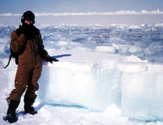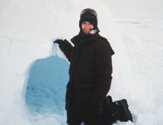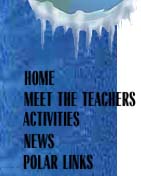
The USCGC Healy
(US Coast Guard Cutter Healy)
in the Canadian Arctic.
(Kolb)
|

The USCGC Healy Bow Wash System
(Deluge System) in the Canadian Arctic ice floe:
The Bow Wash System is employed when there
is an abundance of
snow. Heavy snow renders
the ship less capable and consequently slows it
down.
Water spouts from each side of the bow to wash
the snow off the ice
and to provide a liquid
lubricant to the sides of the ship. This system
reduces the friction of the snow
against the ship and lessens its
resistance.
It facilitates the ship's forward movement
over the ice.
(Refer to my journal
entries of May 6, 2000, "Profiling Ice Thickness" and
May 10, 2000, "Testing Snow Density.")
(Kolb)
|

Standing left is Roger Provost and
coring (left to right) John Gagnon and
Chris Meadus
on Canadian Arctic
ice floe as they collect an ice core to determine
ice strength. (Refer to my journal entry
of May 7, 2000, "Determining Ice Strength.")
(Kolb)
|

Douglas Griggs drilling, Dr. Stephen Jones
documenting, US Navy
personnel in the background
on the Canadian Arctic multi-year ice floe.
They are drilling a core for collecting
and recording ice
temperatures.
(Refer to my journal entry of May 7, 2000,
"Determining Ice Strength.")
(Kolb)
|

An ice core from the Canadian Arctic multi-year ice floe.
The ice core is drilled every 10 cm
for the placement of the probe that is used to collect
and record ice core temperatures.
(Refer to my journal entry of May 7, 2000,
"Determining Ice Strength.")
(Kolb)
|

Stevie Audlakiak (drilling) and Bill Hamburg (standing)
on the Canadian Arctic multi-year floe drilling
to measure ice thickness, snow depth and
free
board. (Refer to my journal entry of
May 6, 2000,"Profiling Ice Thickness.")
(Kolb)
|

John Gagnon on the Canadian Arctic multi-year
floe collecting ice thickness, snow depth and
free board data. (Refer to my journal entry
of May 6, 2000, "Profiling Ice Thickness.")
(Kolb)
|

(left to right standing)-Douglas Griggs, Terry Tucker
(PI and Healy
co-chief scientist), Stevie Audlakiak (Inuit guide),
Roger Provost, Jeff
Andrews
(left to right seated)
Sandra Kolb (TEA), James Qillaq (Inuit guide)
The USCGC Healy Ice Team on a floe
in the Canadian Arctic collecting ice thickness data.
An electromagnetic device is installed
inside the kayak. (Refer to my journal
entry of May 6, 2000, "Profiling Ice Thickness.")
(Kolb)
|

Sandra Kolb (TEA) on the Canadian Arctic
multi-year floe
demonstrating partial
ice thickness and standing just in
front
of the channel broken by the ship into the floe.
Note the brash ice in the
channel path.
(Kolb)
|

Dr. Devinder Sodhi on the Canadian Arctic multi-year
ice floe
collecting data for snow density studies.
(Refer to my
journal entry of May 10, 2000,
"Testing Snow Density.")
(Kolb)
|

USCGC Healy and Ice Profiling Teams (note the colored
parkas in the
background) at work on the Canadian Arctic floe .
(Refer to my journal entries of May 6, 2000,
"Profiling Ice Thickness" and
May 7, 2000, "Determining Ice Strength.")
(Kolb)
|

Sandra Kolb (TEA) on the Canadian Arctic ice floe
demonstrating the completed size of a snow house
large enough
tosleep one or two people.
Note the beautiful bluish light created
from the
sunlight filtering through the snow into the interior.
(Kolb)
|

Nilas Ice in the Canadian Arctic.
Nilas Ice is the second stage of ice development.
The first stage is New Ice and the third stage is Young Ice.
(Kolb)
|


